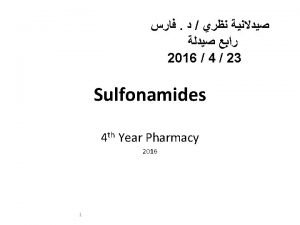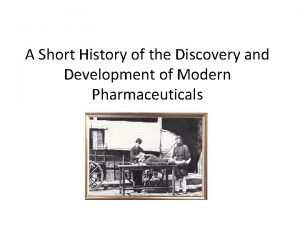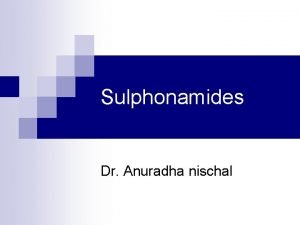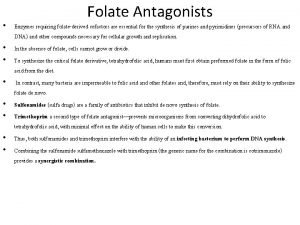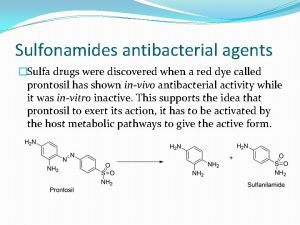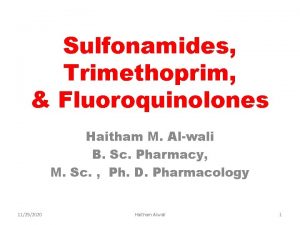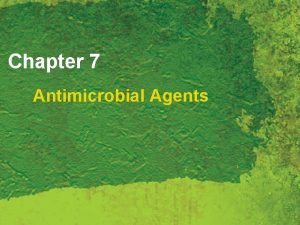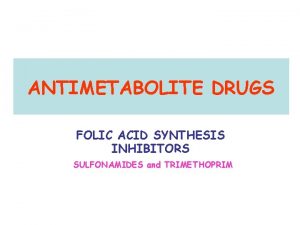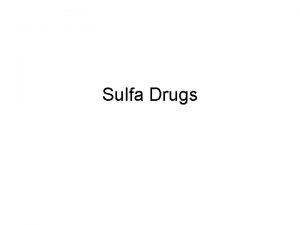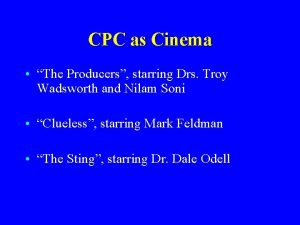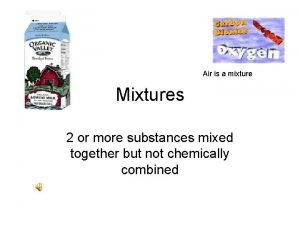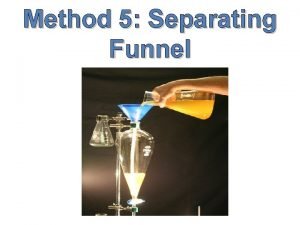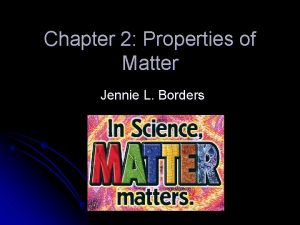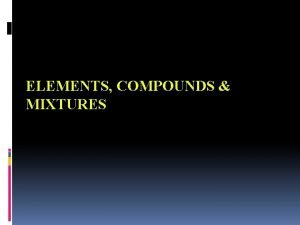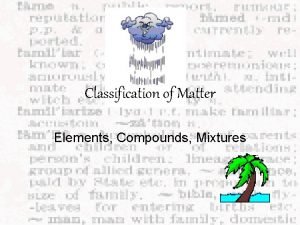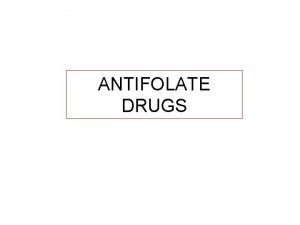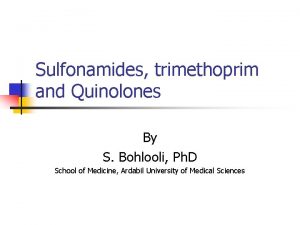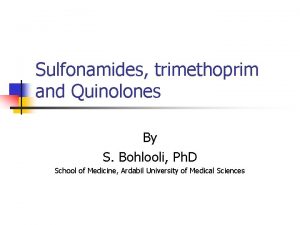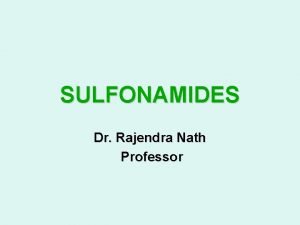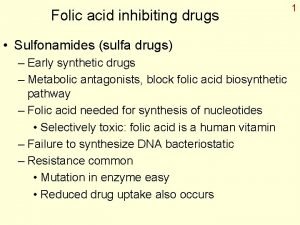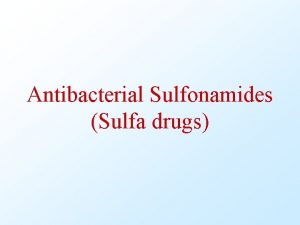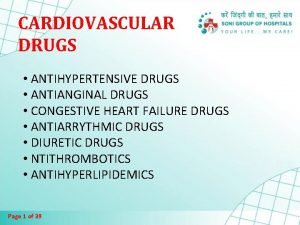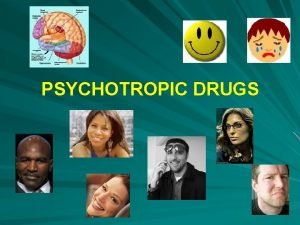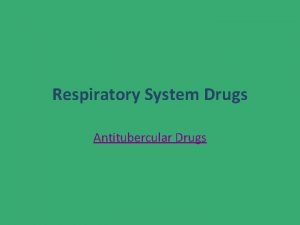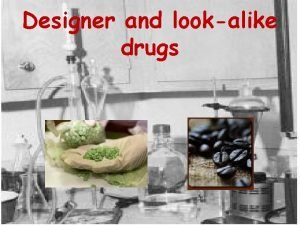Antifolate drugs Sulfonamides Trimethoprim Sulfamethoxazole mixture 2 Lead




















- Slides: 20


Antifolate drugs • Sulfonamides • Trimethoprim & Sulfamethoxazole mixture 2

Lead Compound Notes • Prontosil - red dye • Antibacterial activity in vivo (1935) • Inactive in vitro • Metabolised to active sulfonamide • Acts as a prodrug • Sulfanilamide - first synthetic antibacterial agent acting on a wide range of infections 3

Sulfonamides: mechanism of action • Inhibition of dihydropetroate synthase 4

Mechanism of action para-Aminobenzoic acid Dihydropteroate synthetase _ Reversible inhibition Dihydropteroate Sulfonamides L-Glutamic acid Dihydrofolate reductase NADPH 5 Tetrahydrofolate (coenzyme F) _ Trimethoprim

Mechanism of action Binding interactions H 2 N C O H 2 N O Active site H-Bond van der Waals interactions Ionic bond 6 S O O NR

Synthesis of Sulfa drugs 7

Sulfonamides - Drug Metabolism N-Acetylation Sulfathiazole Notes • Sulfonamides are metabolised by N-acetylation • N-Acetylation increases hydrophobic character • Reduces aqueous solubility • May lead to toxic side effects 8 Insoluble metabolite

Structure-Activity Relationships para-Amino group Aromatic Sulfonamide • para-Amino group is essential (R 1=H) • para-Amido groups (R 1=acyl) are allowed • inactive in vitro, but active in vivo • act as prodrugs • Aromatic ring is essential • para-Substitution is essential • Sulfonamide group is essential • Sulfonamide nitrogen must be primary or secondary • R 2 can be varied 9

Sulfonamides: antimicrobial activity • • • Gram positive and negative bacteria Nocardia, chlamydia trachomatis Some protoza Some enteric bacteria Rickettisiae stimulated! 10

Sulfonamides: resistance • Overproduction of PABA • Low affinity dihydropetroate synthase • Loss of permeability to sulfonamides 11

Sulfonamides: pharmacokinetics • Oral absorbable – Short – Medium – Long • Serum protein bind – 20 ~ 90% • Excreted into urine • Oral, nonabsorbable • topical 12

Pharmacokinetic Properties of Some Sulfonamides and Trimethoprim 13

Sulfonamides: chemistry 14

Sulfonamides: clinical uses • Oral absorbable agents – Sulfisoxazole, sulfamethoxazole • To treat urinary tract infection – Sulfadiazine: toxoplasmosis – Sulfadoxine: long acting, in a combination for treatment of malaria • Oral nonabsorbable agents – Ulcerative colitis, enteritis, other inflammatory bowel disease • Topical agents – Sulfacetamide: ophthalemic – Mafenide & silver sulfadiazine: topically ( Burn ) 15

Sulfonamides: adverse reactions • Cross allergenic sulfonamide drugs: – Thiazide, furosemide, diazoxide, sulfonylurea hypoglycemic agents, and others – Fever, skin rashes, exfoliative dermatitis, photosensivity, urticaria, nausea, vomiting, diarrhea – Stevens-Johnson syndrom • Urinary tract disturbances – Crystalluria, hemturia, obstruction • Hematopoietic disturbance – – Hemolytic or aplastic anemia Granulocytopenia, thrombocytopenia, leukmoid reaction Hemolysis in G-6 PDH deficient patients Kernicterus in newborn of mothers have taken near the end of pergnancy 16

Trimethoprim: chemistry 17

18

Clinical use • Oral trimethoprim – Acute urinary infection • Oral trimethoprim-sulfamethoxazole – P jiroveci pneumonia, shigellosis, systemic salmonella infection, complicated urinary tract infection, – Active against many respiratory pathogens • Intravenous trimethoprim-sulfamethoxazole – Gram negative sepsis, pneumocystis pneumonia – Shigllosis, typhoid fever • Oral pryrimethamine with sulfanamide – With sulfadiazine in Leishmaniasis, toxoplasmosis – With sulfadoxine in malaria 19

Adverse effects • • Megaloblastic anemia Leukopenia, granulocytopenia Can be prevented by folinic acid The AIDS patients have high frequency of unwanted reactions Sulfones ( Dapson) • Thought to inhibit dihydropteroate synthetase • Used in the treatment of leprosy 20
 Oral absorbable sulfonamides
Oral absorbable sulfonamides Drug name
Drug name Homogeneous mixture and heterogeneous mixture class 9
Homogeneous mixture and heterogeneous mixture class 9 Classification of sulfonamide
Classification of sulfonamide Cotrimoxazole mechanism of action
Cotrimoxazole mechanism of action Sulfonamides mechanism of action
Sulfonamides mechanism of action Sulfonamides classification
Sulfonamides classification Sulfonamides
Sulfonamides Methoteraxate
Methoteraxate Sar of sulfonamides
Sar of sulfonamides Sulfonamides classification
Sulfonamides classification Classification of sulfonamides
Classification of sulfonamides Lead magnesium niobate
Lead magnesium niobate Mixture examples
Mixture examples 160% proof rum
160% proof rum Separating funnel uses
Separating funnel uses L
L Blood heterogeneous or homogeneous
Blood heterogeneous or homogeneous Homogeneous mixture
Homogeneous mixture Difference between mixture and compund
Difference between mixture and compund Suspension mixture
Suspension mixture
